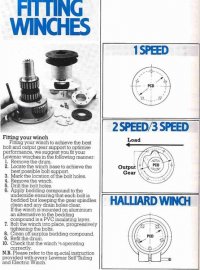I am puzzled by how to best interpret the Lewmar install instructions for my old set(s) of 46 primaries and 43 secondaries.
(They are being reinstalled with new angled risers to cure the occasional override due their being too low on the side deck.)
A copy of the original Lewmar manual page shows that the load should come in toward the "output gear". This guide is easy to follow for the primary winch because most of the time the genoa sheet load comes from ahead of the winch. The secondary winches can have loads coming from the runners, aft, or from a spinnaker snatch block ahead, to the side, or aft.
Anyone know of the difference in intrinsic strength for loads from other than the recommended directions?
Note that the mounting holes are not symmetrical.
Thanks,
Loren
(They are being reinstalled with new angled risers to cure the occasional override due their being too low on the side deck.)
A copy of the original Lewmar manual page shows that the load should come in toward the "output gear". This guide is easy to follow for the primary winch because most of the time the genoa sheet load comes from ahead of the winch. The secondary winches can have loads coming from the runners, aft, or from a spinnaker snatch block ahead, to the side, or aft.
Anyone know of the difference in intrinsic strength for loads from other than the recommended directions?
Note that the mounting holes are not symmetrical.
Thanks,
Loren


